Menus
- What you must remember
- Themore
- Theless
- Prices
- Make yourKawasaki Ninja 1000 ZX-10R KRT Replica 2019
- Opinion
- Replaces
- Performances
- The technical aspect
- Competitors
- Gallery
- Related articles
The ZX-10R celebrates its 15th anniversary this year. The age of pushing at full speed – the explosion of emotions for teens, the pursuit of performance for the Kawa. Succeeding the ZX-9R, the green hypersport has never ceased to seek power. It passes a new stage with an overhaul of the cylinder head and some optimizations.
Its retouched painted ‘Kawasaki Racing Team’ deco exudes aggressiveness. And there are. The wringing of the handle followed by an approach to the red zone will be rewarded with a load of 203 horsepower. Three more units that must be fetched 500 very higher, at 13,500. It is not so much the increase in power that calls out but the technical modifications. The 4-cylinder has opted for pawl distribution, like the BMW S 1000 RR and the latest version of the Suzuki GSX-R 1000 / R. This valve actuation process allows a weight reduction of 20 %, more revs and the introduction of nastier camshafts. To prevent wear, a DLC treatment has been applied.
No jealousy in the range: all ZX-10R receive the new cylinder head (released by the RR). To celebrate, the cylinder head cover is painted red. Worse too, just to keep up with the competition, the ‘base’ Ninja 10R snatches the Up & Down shifter of sisters RR and SE; it only worked on the rise of the reports on the old one.
A touch of makeup and technical optimization to continue on the previous update of 2016. The big Ninja had not really changed visually since its previous version; she had delicately styled herself. With its more chiseled optics, a more elusive rear and a more tapered exhaust, the machine gained in elegance, almost smoothness. With subtle 636 faux-airs, she worked herself out more than she disturbed. The old “bio-medicalized” rear optical unit giving way to a much more successful design. Since then, she gives off that little something imperceptible that gives more class. The fairing’s bow blades are preserved, as are the generous tank covers. It is more revised above the fork crown. Gone is the exception of having a bubble without edges; the cockpit accompanies it on its edges, thus allowing a reduction in vibrations. Miss Ninja seems to be preoccupied with the pilot, thus accompanying the effort and a little respite in the long straights swallowed at full speed. Evidenced by a slightly increased protection and small ears cut almost at the top of the fork crown. This would decrease the depression behind the bubble and limit the helmet shaking.
The pencil, however, did not strain on the drawing tables. It will be necessary to keep an eye out to distinguish the two generations of ZX-10R; we have seen more marked changes.
In competition, it is not really evo design that will be at the center of the discussions. We will rather quote from…
Wait, what are those tubes in front of the brake calipers?!? Heck, that looks furiously like an Ohlins pressurized fork. You know, the kind of front end that you only find on MotoGP, WSBK, EWC machines and Greek shipowners. Let’s come back to earth and appreciate the technology provided by Showa. The technical approach is essentially the same as that of the Swedish manufacturer with its FGR. Damping is no longer managed in the sleeves but in these small external chambers, filled with nitrogen. Suddenly, the cushioning is more stable, the fork works better and allows you to even more appreciate what is happening under the wheel. Until now, this type of fork has only been seen in high-level competition. Showa democratizes it with this BFFF (Balance Free Front Fork), as we gradually saw the inverted forks and radial calipers appear..
And here is the second bonus. This front end has not finished to amaze us. Forget the Tokico and the petal pancakes. Smell the delicate and acrid scent of molten metal under the onslaught of Brembo. This time it’s more than serious. The brake discs announce 330 mm in diameter (+ 20 mm), and on the jaw side, we type in monobloc M50. All under the control of aviation hoses and a master cylinder with radial pump. Something to make a Ducati 1299 Panigale or an MV-Agusta F4 jealous; and you know how it slows down an Italian. But will the transplant take you as well on a Japanese ?!?
ABS? Always present and impossible to ignore it now. The KIBS pushes the vice until it detects a blockage of the rear wheel due to a muscular downshift and therefore does not come into action. It can be deactivated but with an electronic key, supplied in the racing kit (we will come back to this). The Ohlins steering damper is retained, in order to calm the ardor of the management.
Before tackling the chapter of electronic assistance, always more numerous and impressive, let the engine express itself a little. This muscle supercharged the performance of barjot. Do not block on the maximum power of this 4 cylinders. Kawasaki gave it 200 horsepower at the time (210 with the forced air intake), and that was enough to dislodge 99% of what rolls. With 203 nags in 2019, the situation goes up a notch. The work of the engine manufacturers, largely influenced by the work of the KRT, goes in the direction of a fuller engine, breathing better, with less inertia when taking turns (were there?). I will spare you all the technical modifications … But if you really want to, everything will be detailed at the bottom of the sheet. Let us remember above all a larger air box and a much more ventilating filter, a lighter crankshaft, thicker cylinder walls, optimized camshafts, larger exhaust valves, improved gas evacuation, lighter pistons and more robust, a refined admission and a more competitive gearbox. The gears 2 and 6 are shortened, history of squirting of the turn and to hang more easily the maximum speed. Ah, by the way, the said box is located higher, in order to be able to open it without having to empty the mill. Practice.
The power is there, with a desire to be more usable. The choice of cartography accompanies this process. 3 modes are available, delivering 60% (low), 80% (middle) or 100% (full) of the watts of the 998 cm3.
With all of these developments, it makes you wonder if the Kawasaki Racing Team does not want to invite itself into your garage. The electronic arsenal too ?
For the most part, yes. The old ZX-10R already had a response at this level. We move on to the next box, the one between assisted piloting and a manned mission for Mars. The KIBS, as we have already seen above. But the ZX-10R “phase 6” has even more below. The big modification on this Ninja, it is the adoption of the UMI of Bosch, the inertial control on 5 axes (the longitudinal, transverse and vertical acceleration, the angular speed of roll and the speed of pitch). And there are not many bikes on the market to embed this intelligent control module. The last 1299 Panigale and R1 are doing their business brilliantly, the 10R is getting into tune. The manufacturer of Akashi brings him his personal touch with the calculation of the yaw angle, provided by the ECU. With that, the on-board electronics “see” in 3D where the motorcycle is in space and its reactions; it can thus act with great efficiency.
The anti-skating takes full advantage. The S-KTRC no longer relies solely on the difference in speed of the wheels to intervene. With the help of UMI measurements, it can act on the condition of the track, tires, machine glide and type of wheelie. Bluffing! It can now be set on five levels instead of three.
The ZX-10R is also equipped with a Launch Control for cannon starts, even more efficient than that of the H2 and H2R. We also find the KEBC which acts on the engine brake.
S-KTRC, KEBC, UMI, KLCM, KIBS, KQS … We haven’t forgotten anyone? Well yes, this Kawa does not have a structure? Arf, the electronics are so emphasized on these cars that we almost abandon the chassis. While the guy does most of the job. Even better from this point on. We saw that the front axle raised its level of requirements seriously. To transform, it is based on the double perimeter aluminum beam frame, only modified at the level of the thickness of the walls, thinner but also solid. The main changes concern geometry. The steering column is moved back 7.5mm while the swingarm extends 15.8mm. Its increased wheelbase should give a bit more stability, although no one complained about that. As for the chassis modifications, they put more weight on the front wheel, favoring the feeling when entering a curve..
Exactly, the weight. We wonder where Kawa slipped a brick on his 1000 sports car. The technical sheet announces 5 kgs more, that is to say 206 units. Probably the catalyst and other dirt.
The rear mono-shock absorber and its almost horizontal kinematics are renewed; the Showa BFRC Lite is lighter, with a separate damping function (like the fork) and easy adjustments. A weapon this ZX-10R! Finely sharper to cut out the competition.
What is also renewed is this bargraph on the instrument panel, not always appreciated. The instrumentation accommodates a few more indicator lights, the digital window modifies the arrangement of its information a little, and a light sensor allows to automatically vary that of the instrumentation.
The Kawasaki ZX-10R is more in a logic of evolution than a real overhaul. However, this significantly improves an already very high level of efficiency. Perhaps we would have appreciated having the possibility of choosing semi-active suspensions as an option … The bloodiest pilots will concentrate more on the racing kit. It allows you to play on the steering column: a set of spacers allows it to be moved by 4 mm. Another series of parts makes it possible to modify the axis of the swing arm. There are also a whole bunch of engine parts as well as the electronic key mentioned in the chapter on ABS. It allows you to deactivate the anti-lock, to configure the piloting assistance much more finely, to reprogram the ECU in order to gain 10 horsepower and to smooth the power curves..
Now turn the key in the switch, close the visor, let it express itself, drive … You are in racing mode while the chrono is sweating.
A little more technique:
All the evolutionary work that Kawasaki has brought to its ZX-10R spans 29 pages. Let’s focus on the engine and its main technical changes:
– The machining of the intake ducts uses an avant-garde technique borrowed from the Kawasaki team engaged in WSBK: their outlet ports are machined in two stages, first with the valve seats and then at an angle. Thus, the air follows a more rectilinear path entering the combustion chamber. While smoothing the flow, this wider and straighter geometry of the ducts allows a greater volume of air / fuel mixture to be sucked in, to the benefit of the power. As before, the intake ducts are polished.
– In the same perspective of a gain in power, the exhaust ducts are also wider, straighter and now benefit from a polishing.
– The larger diameter of the exhaust valves (Ø 24.5 mm -> Ø 25.5 mm) also increases power, especially at high revs. That of the intake valves is unchanged at 31 mm.
/ Both the intake and the exhaust, the valves are made of titanium, a material with high thermal resistance and which reduces the masses in motion.
The retouched profile of the cams lengthens the crossover period, which benefits power (especially at high rpm).
/ The chromoly camshafts contribute to the lightening of the whole.
– The shape of the combustion chamber evolves for better efficiency of the intake and exhaust
– To manage the higher engine load, the pistons have been shortened (39.2 mm -> 37.7 mm) and their cap redesigned. Each of them is reduced by 5 g, in favor of the engine response. In addition, they are made of a new material that is both more robust and extremely heat resistant. Finally, the addition of a dry lubricating film on the skirt reduces friction at low speed and facilitates the break-in of the piston..
– The moment of inertia of the crankshaft drops by 20% – one of the most important fallout from Team Kawasaki WSBK’s lessons. The performance gain is significant at all levels: acceleration, deceleration and cornering.
– The primary balance shaft is made lighter The new material of the connecting rod bearings increases their endurance at high revs, while their new coating improves resistance to galling.
– At the cylinder, the walls of the bore thicken (5 mm -> 6 mm) in order to adapt the rigidity to the power gain, which also benefits reliability.
– The use of an electronic throttle control justifies the adoption of a new 32-bit electronic control unit (ECU). Resin-free, its aluminum housing promotes heat dissipation, thus reliability.
What you must remember
Themore
Theless
Prices
18,099 €
Price
nine
Compare
the credits
Make
yourKawasaki Ninja 1000 ZX-10R KRT Replica 2019
Estimate, calculate and compare the cost of insuring your motorcycle.
Calculate the cost of
insurance
Test the price of the motorcycle insurance specialist
Opinion
on 3 opinion
users
Read the reviews
Replaces
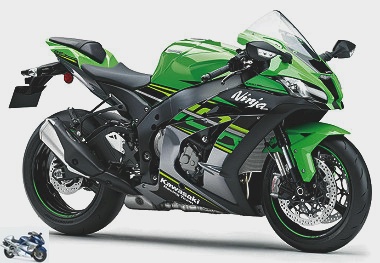
Ninja 1000 ZX-10R KRT Replica 2018
Model marketed in
2016
2017
2018
2019
2020
Performances
-
Max speed:
300 km / h
The technical aspect
Kawasaki Ninja 1000 ZX-10R KRT Replica 2019
- Frame
- Frame: double perimeter aluminum beam
- Tank: 17 liters
- Seat height: 835 mm
- Length: 2,085 mm
- Width: 740 mm
- Height: 1,145 mm
- Wheelbase: 1440 mm
- Operating weight: 206 kg
- Train before
- BPF inverted telehydraulic fork Ø 43 mm, deb: 120 mm
- 2 Ø 330 mm discs, 4 piston radial calipers
- Front wheel:
120/70
– 17
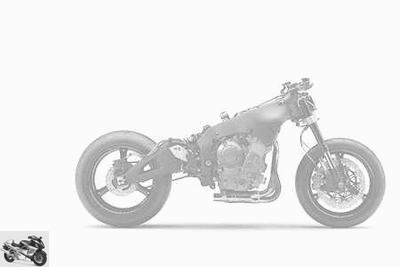
- Transmission
- 6 speed gearbox
- Secondary chain transmission
- Rear axle
- Mono-shock, deb: 114 mm
- 1 disc Ø 220 mm, 1 piston caliper
- Rear wheel:
190/55
– 17
- Motor
- 4 Cylinders
in line
, 4 stroke - Cooling: Liquid cooling
- Injection Ø 47 mm
- Double ACT
- 4 valves per cylinder
-
998 cc
(76 x 55 mm) -
203
ch
at 13,500 rpm - 213 hp with forced air
-
11.70 mkg
at 11,200 rpm - Compression: 13: 1
- Crit’air:
Detached pieces
exhaust
motor
fluid
electricity
filtration
braking
chain kit
Competitors
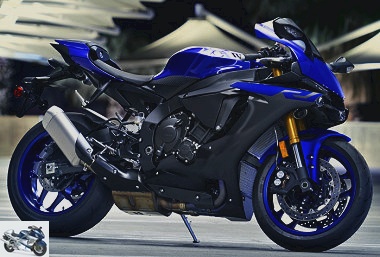
2019 Yamaha YZF-R1 1000
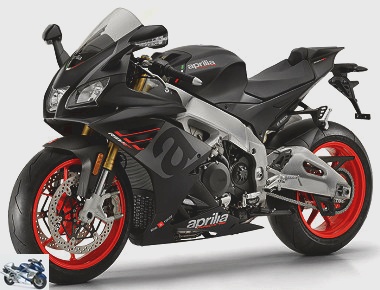
Aprilia 1000 RSV4 RR 2019
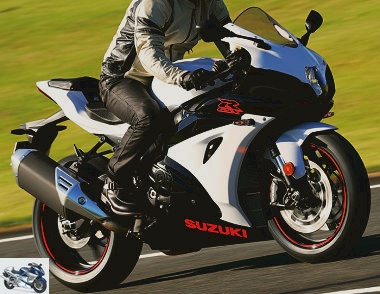
Suzuki GSX-R 1000 2019
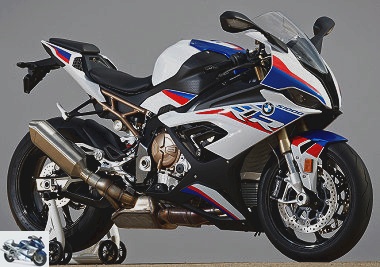
2019 BMW S 1000 RR
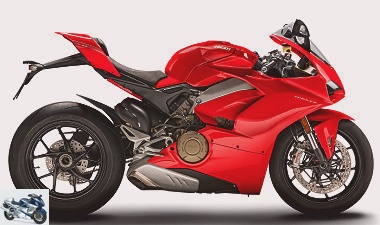
Ducati 1100 Panigale V4 2019
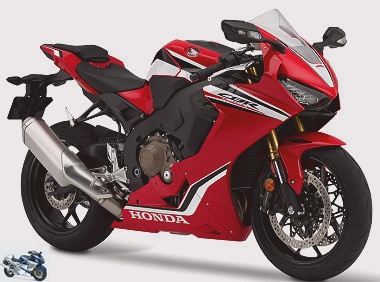
2019 Honda CBR 1000 RR Fireblade
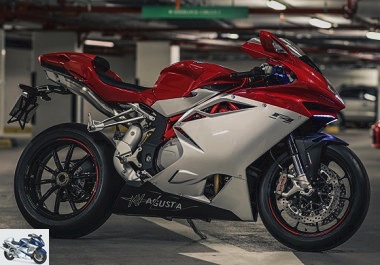
2019 MV-Agusta F4 1000
Gallery

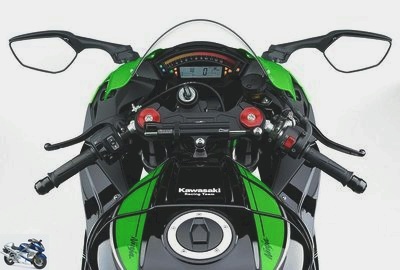
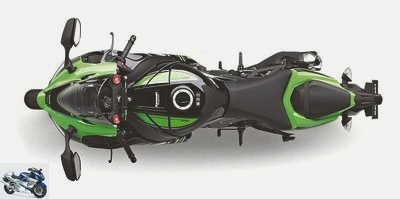
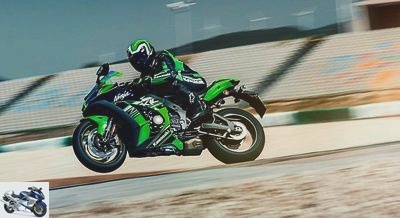
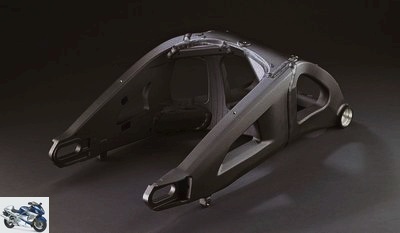
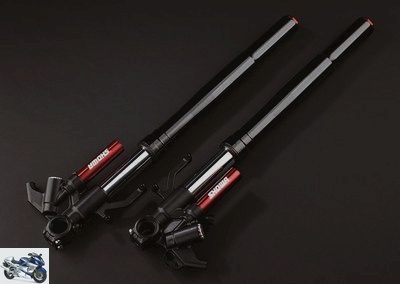
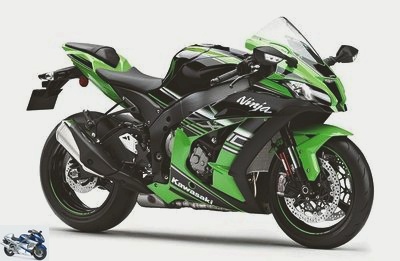

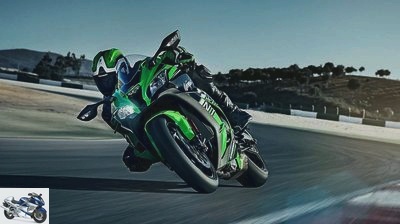
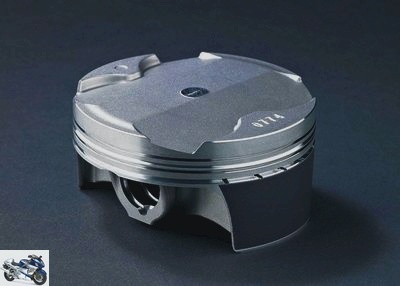
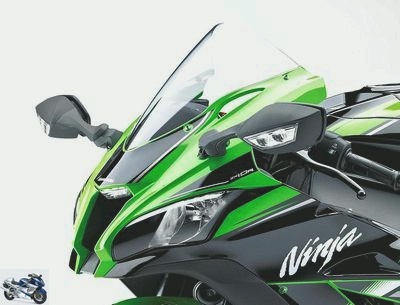
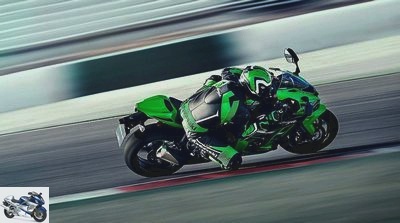
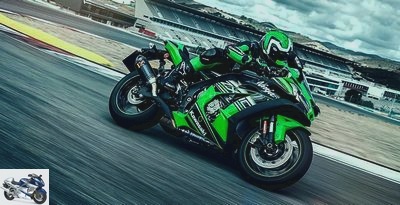
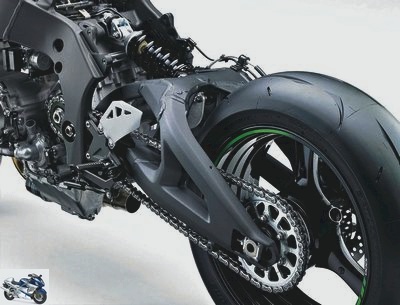
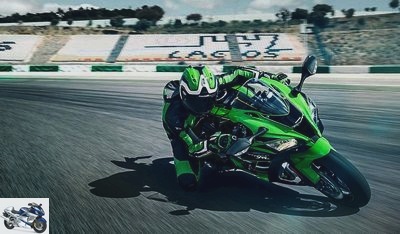

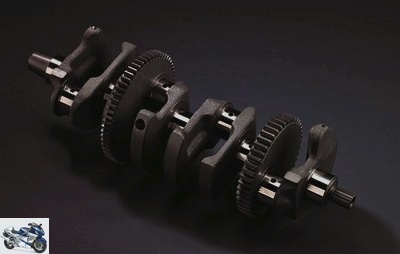
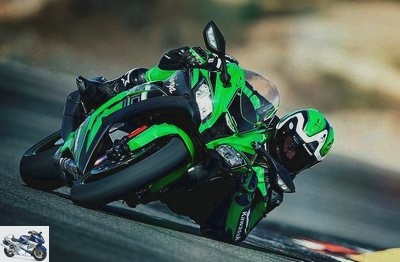

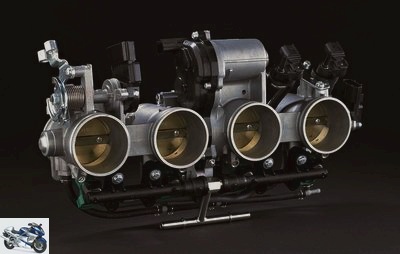
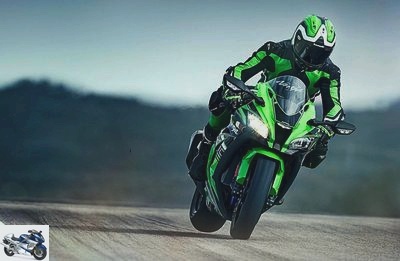

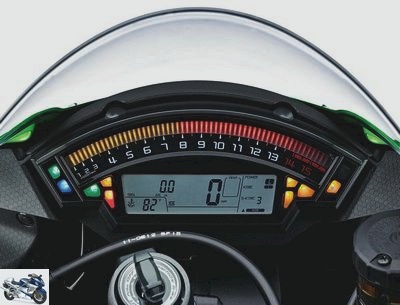
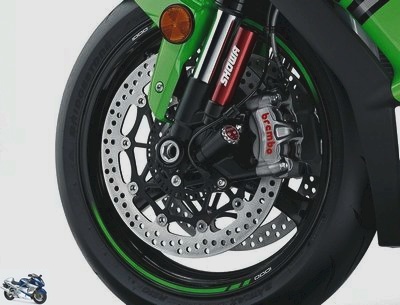
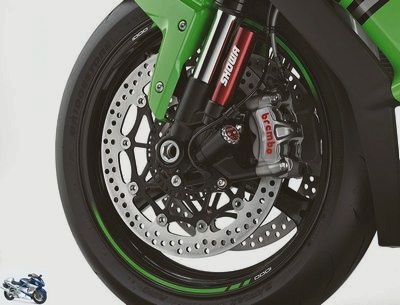
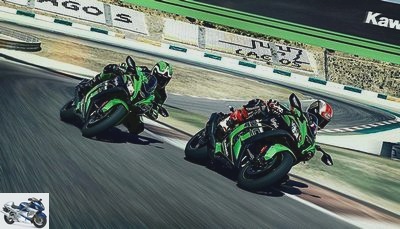
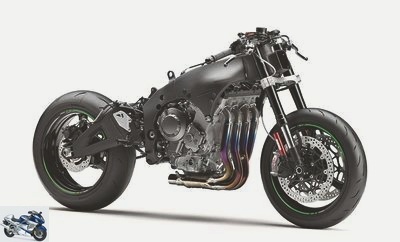

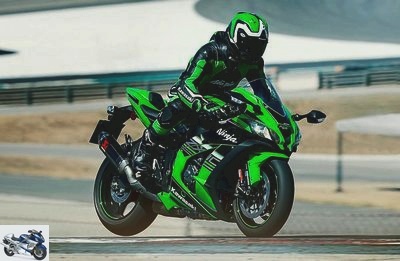
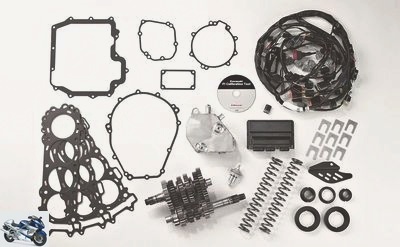
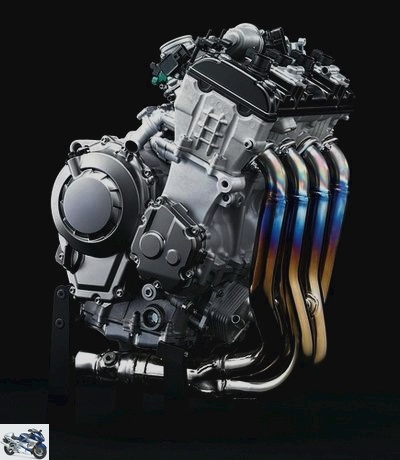
Related articles
-
Kawasaki Ninja 1000 ZX-10R KRT Replica 2020
The ZX-10R is always looking for power. Last year, its mechanics were entitled to the right care to gain watts. It passed a new stage with a revision of…
-
Kawasaki Ninja 1000 ZX-10R KRT Replica 2018
Some retouching in 2018 for the KRT Replica colorway; just enough to make it a little more tangy. Becoming the identity of the Ninja in the range, this…
-
Victorious and feared in World Endurance (three victories in a row at the 24 Hours of Le Mans and the Bol d’or + Mans double in 2012), untouchable in…
-
A new 10-R! Completely redesigned, completely dedicated to the track, more sulphurous and powerful than ever. Do you want the numbers? Not right away,…
-
A new 10-R! Completely redesigned, completely dedicated to the track, more sulphurous and powerful than ever. Do you want the numbers? Not right away,…
-
All superlatives have been used to define H2R. Some minor changes will thus have difficulty finding an echo in the aura of this exceptional motorcycle….
-
Kawasaki ZX-10R 1000 KRT Replica 2017
We like this KRT Replica colorway. Not content with appropriating all the Ninjas in the range, this decoration won a free ride in 2017 to accompany the…
-
Kawasaki ZX-10R 1000 KRT Replica 2016
With the number of victories it has collected in WSBK, the ZX-10R can without restraint claim to be the ultimate mistress of the best drivers in the…
-
Kawasaki hypersport is more efficient than ever. Impressive efficiency, few rivals come close to it. Its developments in 2016 have made it a major asset…
-
It started with a breath coming from afar, where 4 perfect drops fell from a saber into the sea. From this rustling was going to be born a terror, a…